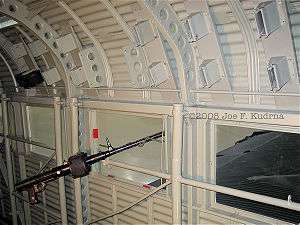MG 15
| MG 15 machine gun | |
|---|---|
|
MG 15 in left beam mounting inside a Ju 52, and above it storage brackets for 12 MG 15 magazines, with one magazine mounted. | |
| Type | Machine gun |
| Place of origin | Nazi Germany |
| Service history | |
| Used by |
Nazi Germany Imperial Japan (Type 98) |
| Wars | World War II |
| Production history | |
| Designer | Theodor Bergmann |
| Designed | 1920s |
| Manufacturer | Bergmann (Weimar Republic), Rheinmetall (Third Reich) |
| Variants |
Modular design Type 98 (Direct Japanese copy) |
| Specifications | |
| Weight | 12.4 kg (27 lb) loaded with gunsight and cartridge bag |
| Length | 1,078 mm (42.4 in) (without attachments) |
| Barrel length | 690 mm (27 in) |
|
| |
| Cartridge | 7.92×57mm Mauser |
| Caliber | 7.9mm |
| Action | Recoil |
| Rate of fire | 1,000 - 1,050 rpm |
| Muzzle velocity | 755 m/s (2,480 ft/s) |
| Feed system | 75-round double-drum magazine |
| Sights | Various types |
The MG 15 was a German 7.92 mm machine gun designed specifically as a hand manipulated defensive gun for combat aircraft during the early 1930s. By 1941 it was replaced by other types and found new uses with ground troops.
History
The MG 15 was developed from the MG 30 which was designed by Rheinmetall using the locking system invented by Louis Stange in the mid to late 1920s. Though it shares the MG 15 designation with the earlier gun built by Bergmann, the MG 15nA (for neuer Art, meaning new model having been modified from an earlier design) has nothing in common with the World War II gun except the model number. The World War I gun used a tipping lock system while the WWII aircraft gun uses a rotating bolt/lockring. The World War II MG 15 was used in nearly all Luftwaffe aircraft with a flexible-mount defensive position.
It was a modular design with various attachments that could be quickly attached or removed. Operation was easy and the bolt remained in the cocked position after expending the 75 round double drum (also called a "saddle drum") magazine, negating the need to re-cock once a fresh magazine was installed.
The MG 15 fires from an open bolt, meaning that the bolt stays back when the gun is ready to fire, and also making it nearly impossible for "through the propeller" synchronized forward firing on a fuselage mount. Pulling the trigger releases the bolt and allows it to go forward, stripping a round from the magazine. The bolt continues pushing the round into the chamber and locks up when the lockring rotates and locks the bolt and barrel extension together. At this point the trip lever releases the firing pin and the gun fires. Recoil pushes the barrel, lock and bolt backwards until the lockring hits a cam that rotates it unlocking the bolt and barrel. Inertia carries the bolt backwards until the base of the fired case hits the ejector flinging the empty out of the receiver. If the trigger is held down the cycle will continue. If the trigger is released the bolt will remain in the rearward position.
The 75 rounds of ammunition was evenly distributed in each side of the magazine with a central feed "tower" where the ammunition is fed to the bolt. Various methods where used to secure the magazines in the aircraft, while a carrier of 3 mags each were used on ground. Ammunition was fed by a spring forced spiral double-drum containing 75 rounds total (not 150 as is often mistaken). This combined with a firing rate of 1000+ rpm means it could empty the magazine in 4.5 seconds or less. Typical practice was to provide at least 10 reloads for each gun on the aircraft, not including the magazine on the gun.
Starting in late 1940 the MG 15 was replaced by the Mauser 7.92 mm MG 81, MG 81Z (twin-MG 81), MG 131 13 mm machine guns, or MG 151/20 20 mm cannons. Many MG 15s were modified for infantry use as heavier weapons replaced them on Luftwaffe aircraft. There are a number of pictures showing the guns, both aircraft and ground versions, with 25-round magazines from the MG 13 but the magazines don't actually work with the MG 15. Official numbers of conversions was about 17,648 by January 1, 1944, although additional conversions may have been done as well.
The MG 15 was used in the Japanese aircraft as the Type 98 flexible-mounted machine gun and as the Type 1 in the Imperial Japanese Navy.[1]
Specifications
.jpg)
- Calibre: 7.9 +/- .04 mm
- Cartridge: 7.92×57mm Mauser
- Round weight: 35.5 grams (cartridge 24 grams, bullet 11.5 grams)
- Muzzle velocity: 755 metres per second (2,480 ft/s)
- Rate of fire: 1000 (possibly up to 1050) rpm
- Length : 1,078 millimetres (42.4 in) (without attachments)
- Barrel length: 600 millimetres (24 in)
- Weight unloaded with gunsight and cartridge bag: 8.1 kg (18 lb)
- Weight loaded with gunsight and cartridge bag: 12.4 kg (27 lb)
- 75-round magazine unloaded: 2.27 kg (5.0 lb)
- 75-round magazine loaded: 4.24 kg (9.3 lb)
- Weight of the 2-part loader: 0.72 kg (1.6 lb)
References
- L.Dv 110 Beschreibung und Bedienungsvorschrift für das M.G. 15, Manual for using MG 15 owned by contributor (may not be correct German spelling)
- Panzerfaust WW II German Infantry Anti-Tank Weapons Page 5: Machine Guns.
- MG 15 in private collection, forum site
- Imperial Japanese Weapons
